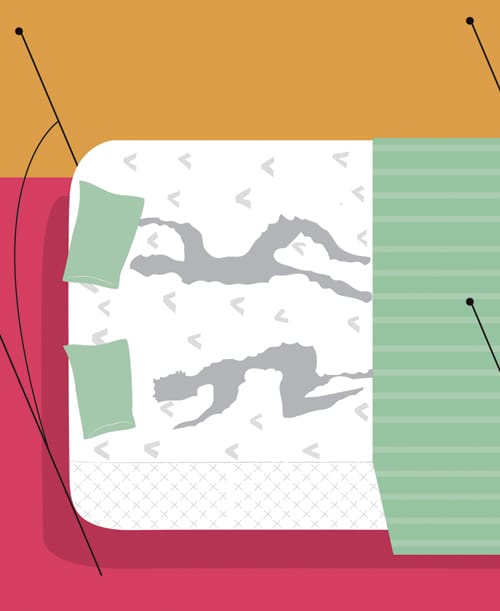
Bedtime Story: Taking the Measure of Mattresses
I have no idea what kind of mattress I slept on as a kid. It might have been soft. It might have been firm. Heck, it might have had a plank under it, for all I know. Come 9 p.m., someone of authority said, “Go to bed,” and off I went. The bed was comfortable, the sheets were soft, the blankets warm. Daddy came in during the night to cover me, and he woke me for school in the morning by wiggling my big toe. Beyond that, I was on my own.
But now, getting a good night’s sleep is more complicated. Having too many newfangled bedding options doesn’t help the natural process. Rather, it confuses. Since my childhood days on who-knows-what-kind of mattress, we’ve seen the emergence of waterbeds, pillowtops, egg-carton toppers, inflatable mattresses, and, worse yet, Sleep Number beds. I was privy to an experience with that last innovation a few years ago, when my sister and I occupied an out-of-town hotel boasting the contraptions. She tried diligently to get hers to a preferred position, but I merely lifted up and sank down, like a plane trying to find a comfortable cruising altitude. As I madly punched buttons, my sister began riding in similar fashion. Once we figured out the housekeeping department had switched our remote controls, we managed our own sleeping apparatuses—badly. This reached its comical low point in the morning, by which time I had sunk so far down into the bed that my sister looked over and, not able to see me below the edge of the mattress, thought I had left the room.
Over the years, my husband and I have owned several king-sized mattresses, although we never fell victim to sloshing around on a waterbed. We liked our pillowtop until the soft layer, flattened over time, left hard springs below. After that, we opted for soft mattresses, crafted in one solid piece. The good news is that these are quite comfy. The bad news is that they leave body impressions. Neither of us is a large person, but even once the quilted coverlet was in place, it looked like Shrek and Fiona had occupied the bed.
The trouble is, you inevitably land in these indentations. This reminds me of my high-school friend, Jackie, whose mother was a wisp of a thing and her father a corpulent man who spent his leisure time smoking cigars in a recliner. Her mother held onto a straight-backed chair at the side of their bed to keep from rolling into the deep valley her husband inhabited. Anytime I needed to amuse myself, I pictured Jackie’s parents in their bedroom, her mother hanging on for dear life.
But now older age has set in for my husband and me, and with it varying degrees of aches and pains. Truth be told, I’ve been feeling like the Tin Man in the mornings as I shuffle into the shower, holding my bad shoulder with my good hand. A steady stream of hot water usually alleviates the misery, but in search of a better solution, we decided to follow the advice of a trusted orthopedist and purchase a Tempur-Pedic mattress. Do not confuse this with a Sleep Number bed, oh, no. This one is much simpler: a 76-by-80–inch flat rectangle of chipped polyurethane foam enclosed in polyester that sits atop boxes with no springs and costs nearly $5,000.
The salesman assured us we’d feel better in the mornings if only we’d try out the Cloud Luxe model. It is made of memory foam, which hugs every body part and lifts back to its original shape once the sleeper has evacuated. You have 100 days to test the bed, which is good because it takes some getting used to. The memory foam molds to every curve, fat blob, protruding hip, or bony shoulder blade, which is quite comfortable. But once you’re in said groove, it takes a bit of maneuvering to get out. Turning over requires lifting yourself up on your elbows and launching full-force in another direction, where, once settled, you make new grooves. At least I’m getting my aerobic activity in while I sleep.
There is no sitting on the side of the bed for purposes of a gradual awakening or donning your socks. Your backside makes a new trench, most likely larger than the ones you just vacated, and, if you’re not careful, you’ll slide right to the floor, at which point you might as well crawl on your aching knees to the shower. There will be no more monkeys jumping on the bed, unless they find hilarity in ending up shoulder-deep in memory foam. And there’s a certain odor to the mattress, described by our salesman as petroleum-based. This is supposed to dissipate with time, although well into Day 60, we continued to feel like we were sleeping aboard the Exxon Valdez.
I am a lousy sleeper but a vivid dreamer, and lately I’ve imagined that Simon Cowell was standing in my bedroom, that I became a dental hygienist with no training, and that McDonald’s discontinued large-size soft drinks. I don’t believe I can blame these nocturnal mental excursions on my new mattress—but I prefer that over psychosis.
We’ve become accustomed to leaving the bed with what appears to be a temporary crime-scene drawing of our bodies imprinted on the mattress, and I suspect we’ll keep the dang thing—that is, until somebody comes up with something better, say, an organic goose-feather mattress that puffs up like cumulus clouds, smells like orange blossoms, and gently boosts you from your back to your side with no more than a wisp of air. Either way, sleep will come, and, with it, hope for sweet dreams, as my father once wished me in the darkness.
Illustration by Andrea Eberbach
This article appeared in the January 2014 issue.





